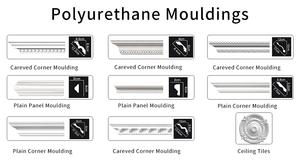
All categories
Featured selections
Trade Assurance
Buyer Central
Help Center
Get the app
Become a supplier

(1338 products available)













































Decorative polystyrene foam cornice are architectural elements made from lightweight polystyrene foam. These materials are used to add decorative and functional finishing touches to interior spaces. Here are the different types of decorative polystyrene foam cornice:
Plain Cornice:
Plain cornice is also known as simple or traditional cornice. It is the most basic form of cornice. This type of cornice features a simple design that combines elegance and functionality. It consists of a straight, slightly recessed profile. This profile is characterized by clean lines and a subtle curve at the ceiling junction. It serves the purpose of hiding the junction between the wall and ceiling. It also provides a finished look to the room without decorative elements.
Ornate Cornice:
The ornate cornice offers a more decorative and detailed approach. It is suitable for grand or traditional interiors. It features intricate patterns, scrolls, floral motifs, and other decorative elements. It adds a touch of luxury and craftsmanship to any space. This type of cornice is often used in spaces where a dramatic visual impact is desired.
Modern Cornice:
Modern cornice is designed for contemporary interiors. It focuses on minimalism and clean lines. It has a sleek profile with sharp angles and without excessive ornamentation. It provides a sophisticated finishing touch to modern spaces with its simple yet impactful design.
Lighted Cornice:
The lighted cornice integrates lighting to create ambience and visual interest. It features a hollow section where LED strips or other types of lighting fixtures are installed. This type of cornice allows for indirect lighting. Indirect lighting is where the light is projected onto the ceiling or wall. It creates a soft, dramatic glow enhancing the overall mood of the room.
Coffered Cornice:
The coffered cornice creates a grid-like pattern of recessed squares or rectangles. This type of cornice adds depth and architectural interest to the ceiling. It is made up of polystyrene foam panels that fit into the framework of beams and moldings. The coffered cornice is popular in formal dining rooms and conference rooms.
Decorative cornices are essential elements in architectural design. They offer a transition between walls and ceilings. These products perform various functions and have different features, including:
There are many applications for decorative polystyrene foam cornices, including:
When choosing the right foam cornice for your construction business, consider a few things. First, consider the style and architecture of the building. The foam cornice should complement the building's design to ensure structural cohesion. Also, consider the size and scale. Choose a cornice that will be visible but not overwhelming. Another thing to consider is the budget. There are different types of foam cornices with varying prices. Set a budget to help choose the option that is more affordable without compromising quality.
Also, consider the durability and weather resistance of the foam cornice. Choose one that can withstand different types of weather conditions if it is an outdoor installation. The installation process is also important. Choose a foam cornice that is easy to install to save on labor costs.
Consider the maintenance of the foam cornice. It should require little to no maintenance to avoid incurring extra costs. Lastly, customer reviews are important. Read the reviews to gain insight into the performance of the foam cornice to help make a final decision.
Q: Is it difficult to install foam cornices?
A: Installing foam cornices is generally very simple. They can be installed using construction adhesive without the need for nails or screws.
Q: Can foam cornices be painted over?
A: Yes, foam cornices can be painted over using water-based paints. Acrylic paint is a suitable foam cornice paint.
Q: Are foam cornices waterproof?
A: Foam cornices are not waterproof but are water resistant. They do not absorb water even when exposed to moisture.
Q: Do foam cornices come in different styles?
A: Yes, foam cornices come in different styles. There are plain designs for contemporary styles and ornate designs for traditional decor.
Q: How should foam cornices be cleaned?
A: Foam cornices should be cleaned using a soft cloth dipped in soapy water. Harsh chemicals should be avoided to prevent damage.